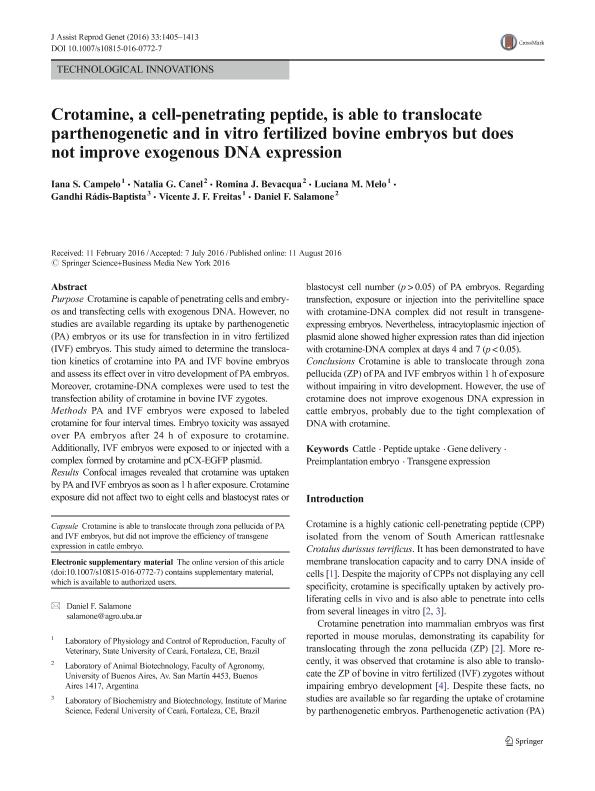Mostrar el registro sencillo del ítem
dc.contributor.author
Campelo, Iana S.
dc.contributor.author
Canel, Natalia Gabriela

dc.contributor.author
Bevacqua, Romina Jimena

dc.contributor.author
Melo, Luciana M.
dc.contributor.author
Rádis Baptista, Gandhi
dc.contributor.author
Freitas, Vicente J. F.
dc.contributor.author
Salamone, Daniel Felipe

dc.date.available
2018-07-05T19:52:46Z
dc.date.issued
2016-10
dc.identifier.citation
Campelo, Iana S.; Canel, Natalia Gabriela; Bevacqua, Romina Jimena; Melo, Luciana M.; Rádis Baptista, Gandhi; et al.; Crotamine, a cell-penetrating peptide, is able to translocate parthenogenetic and in vitro fertilized bovine embryos but does not improve exogenous DNA expression; Springer/Plenum Publishers; Journal of Assisted Reproduction and Genetics; 33; 10; 10-2016; 1405-1413
dc.identifier.issn
1058-0468
dc.identifier.uri
http://hdl.handle.net/11336/51424
dc.description.abstract
Purpose: Crotamine is capable of penetrating cells and embryos and transfecting cells with exogenous DNA. However, no studies are available regarding its uptake by parthenogenetic (PA) embryos or its use for transfection in in vitro fertilized (IVF) embryos. This study aimed to determine the translocation kinetics of crotamine into PA and IVF bovine embryos and assess its effect over in vitro development of PA embryos. Moreover, crotamine-DNA complexes were used to test the transfection ability of crotamine in bovine IVF zygotes. Methods: PA and IVF embryos were exposed to labeled crotamine for four interval times. Embryo toxicity was assayed over PA embryos after 24 h of exposure to crotamine. Additionally, IVF embryos were exposed to or injected with a complex formed by crotamine and pCX-EGFP plasmid. Results: Confocal images revealed that crotamine was uptaken by PA and IVF embryos as soon as 1 h after exposure. Crotamine exposure did not affect two to eight cells and blastocyst rates or blastocyst cell number (p > 0.05) of PA embryos. Regarding transfection, exposure or injection into the perivitelline space with crotamine-DNA complex did not result in transgene-expressing embryos. Nevertheless, intracytoplasmic injection of plasmid alone showed higher expression rates than did injection with crotamine-DNA complex at days 4 and 7 (p < 0.05). Conclusions: Crotamine is able to translocate through zona pellucida (ZP) of PA and IVF embryos within 1 h of exposure without impairing in vitro development. However, the use of crotamine does not improve exogenous DNA expression in cattle embryos, probably due to the tight complexation of DNA with crotamine.
dc.format
application/pdf
dc.language.iso
eng
dc.publisher
Springer/Plenum Publishers

dc.rights
info:eu-repo/semantics/openAccess
dc.rights.uri
https://creativecommons.org/licenses/by-nc-sa/2.5/ar/
dc.subject
Cattle
dc.subject
Gene Delivery
dc.subject
Peptide Uptake
dc.subject
Preimplantation Embryo
dc.subject
Transgene Expression
dc.subject.classification
Otras Biotecnología Agropecuaria

dc.subject.classification
Biotecnología Agropecuaria

dc.subject.classification
CIENCIAS AGRÍCOLAS

dc.title
Crotamine, a cell-penetrating peptide, is able to translocate parthenogenetic and in vitro fertilized bovine embryos but does not improve exogenous DNA expression
dc.type
info:eu-repo/semantics/article
dc.type
info:ar-repo/semantics/artículo
dc.type
info:eu-repo/semantics/publishedVersion
dc.date.updated
2018-06-22T14:35:07Z
dc.journal.volume
33
dc.journal.number
10
dc.journal.pagination
1405-1413
dc.journal.pais
Estados Unidos

dc.journal.ciudad
Nueva York
dc.description.fil
Fil: Campelo, Iana S.. State University of Ceará; Brasil
dc.description.fil
Fil: Canel, Natalia Gabriela. Consejo Nacional de Investigaciones Científicas y Técnicas; Argentina. Universidad de Buenos Aires. Facultad de Agronomía. Pabellón de Zootecnica. Laboratorio de Biotecnología Animal; Argentina
dc.description.fil
Fil: Bevacqua, Romina Jimena. Consejo Nacional de Investigaciones Científicas y Técnicas; Argentina. Universidad de Buenos Aires. Facultad de Agronomía. Pabellón de Zootecnica. Laboratorio de Biotecnología Animal; Argentina
dc.description.fil
Fil: Melo, Luciana M.. State University of Ceará; Brasil
dc.description.fil
Fil: Rádis Baptista, Gandhi. State University of Ceará; Brasil
dc.description.fil
Fil: Freitas, Vicente J. F.. State University of Ceará; Brasil
dc.description.fil
Fil: Salamone, Daniel Felipe. Consejo Nacional de Investigaciones Científicas y Técnicas; Argentina. Universidad de Buenos Aires. Facultad de Agronomía. Pabellón de Zootecnica. Laboratorio de Biotecnología Animal; Argentina
dc.journal.title
Journal of Assisted Reproduction and Genetics

dc.relation.alternativeid
info:eu-repo/semantics/altIdentifier/doi/https://dx.doi.org/10.1007/s10815-016-0772-7
dc.relation.alternativeid
info:eu-repo/semantics/altIdentifier/url/https://link.springer.com/article/10.1007%2Fs10815-016-0772-7
Archivos asociados
